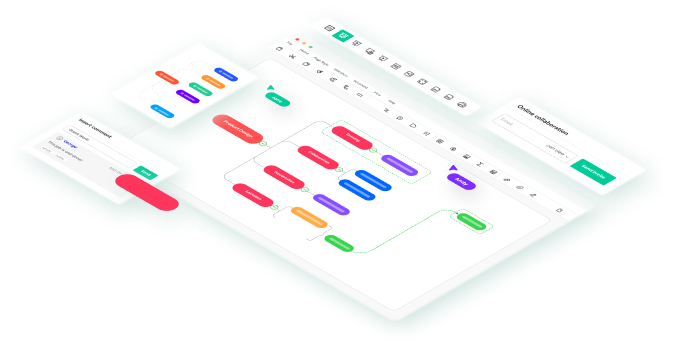Toyota’s Kanban system was a response to manufacturing inefficiencies and inventory problems. But it quickly grew into a cornerstone of workflow management.
In this guide, I'll explore Kanban’s development and roots in practical needs. I'll also explain why its structure appeals to sectors far beyond manufacturing.
By tracing its origin, you can understand how Kanban provides a clear, adaptable system for managing resources, tasks, and time.
In this article
What is Kanban?
Developed at Toyota, Kanban is a visual system that helps minimize waste and increase productivity. Teams use it to monitor tasks, limit work-in-progress, and optimize processes. It’s adaptable and used in manufacturing, software, health and more.
The Key Elements of Kanban
Kanban Cards
These cards represent tasks or units of work. They can be physical or digital and move through different process stages, signaling when action is required.
In Toyota's case, the cards indicated when parts were needed on the production line to maintain a steady flow.
Kanban Board
This visual tool tracks work across different stages. It’s usually divided into columns, such as To Do, In Progress, and Done. This layout allows team members to quickly see where each task stands.
For Toyota to prevent delays, it helped employees understand what needed attention and when.
The Six Rules of Kanban
These are the guiding principles that keep the system efficient and effective. The rules are:
- Visualize The Workflow – Make work visible using Kanban boards and cards.
- Limit Work In Progress (WIP) – Avoid bottlenecks by limiting tasks at each stage.
- Focus On Flow – Ensure tasks move smoothly through the system.
- Make Process Policies Explicit – Clearly define how work moves.
- Implement Feedback Loops – Regular reviews help improve the system.
- Improve Collaboratively, Evolve Experimentally – Continuously refine processes with feedback.
Kanban boards allow you to track tasks, limit ongoing work, and maintain a smooth flow. This makes the process more predictable.
How Toyota Invented Kanban?
Kanban took shape from a simple inspiration: supermarkets. Toyota’s Taiichi Ohno saw how stores used visuals to manage their stock and realized it could help factories, too.
In the 1940s, Toyota’s production line struggled. Parts arrived off-schedule, creating waste and missed deadlines. The push-based inventory system didn’t account for demand, leading to inefficiencies. Ohno’s Kanban changed the process by restocking only when parts were required.
A kanban card represented a part or material and signal when more material was needed. After use, the card was sent back to trigger a new delivery.
This pull system ensured work was done only when necessary, avoiding overproduction. The Kanban board helped them track development through different stages.
How Has Kanban Worked in Toyota Since Then and Spread?
Toyota’s early days with Kanban weren’t smooth. Balancing inventory was tough, but they used real-time data to stay on track.
The company also worked with suppliers to adapt to the system, eventually streamlining the supply chain.
Kanban has shown remarkable flexibility and efficiency. Toyota adopted it based on its Production System (TPS), which has grown into a global standard in lean manufacturing.
How Kanban Helped Toyota?
By switching to Kanban’s pull-based system, Toyota eliminated key production hurdles. They had been dealing with frequent supply lags and inventory overflows, raising costs and delaying output.
Kanban resolved these issues by allowing each production phase to signal for parts only as needed. It not only reduced waste but speeded up the timeline.
This visual process made it simple for team members to spot and tackle bottlenecks quickly. As a result, Toyota could stay on schedule without compromising product quality.
“Toyota cut inventory by 75% and reduced shortages by 95% in only three years.”
The Global Spread of Kanban
Toyota’s implementation of Kanban quickly captured global attention. Similar systems began appearing in factories worldwide by the 1970s. They realized Kanban’s ability to improve supply chains and cut down waste.
As the years passed, Kanban moved beyond manufacturing. It found its place in software development, healthcare, finance, etc.
By the 2000s, software teams embraced Kanban boards for managing tasks and tracking project progress.
The simple layout—To Do, In Progress, Done— was helping teams stay organized, identify issues, and keep things moving. Later on, it evolved into a widely used project management method.
Kanban's Growth and Technological Integration
Kanban’s success lies in how it adapts to developing industries and technology. Digital platforms now bring Kanban to teams everywhere. This adaptability has made it an essential part of agile methods and continuous improvement.
Each new use case shows Kanban’s strength in handling workflows that need ongoing management and fine-tuning.
For example, it assists in managing patient flow and prioritizing treatment in healthcare. In retail, it supports inventory tracking and efficient restocking.
Kanban’s Ongoing Importance
Today’s businesses need tools that balance efficiency and adaptability, and Kanban fits the bill perfectly. It stands apart from traditional project management, offering teams a way to adjust to new demands on the go.
Kanban’s flexibility is a huge asset for companies in volatile markets or those focused on ongoing innovation.
The system encourages steady improvement with real-time feedback. It helps teams refine their processes based on data. By limiting tasks and increasing workflow transparency, Kanban keeps teams focused and reduces overload.
From Kanban’s origin at Toyota to its modern applications, it remains a trusted approach to managing change.
Best Kanban Tools
While sticky notes work for simple tasks, complex workflows require digital tools to implement Kanban. Kanban software offers boards, customized workflows, collaboration, data insights, and more. Based on my thorough testing, here are the best options.
EdrawMind
Mind mapping and Kanban come together in one smooth interface with EdrawMind. It lets you manage tasks easily while organizing ideas visually. You can create boards, track progress, and customize your workflow.
Features and Benefits
- Visual Workflow Management: Visualize your tasks with EdrawMind's clear, simple boards, keeping everything organized.
- Planning Made Simple: Use mind maps to gather ideas, then move them into a Kanban board for easy task management.
- Ease-of-Use: The intuitive interface helps you assess task status and detect workflow issues effortlessly.
- Customizability: You can personalize your Kanban boards by adjusting colors and modifying data, columns, and labels.
- Cross-Platform Compatibility: Access your Kanban boards from any device, making task management simple and efficient.

Kanban Tool
Kanban Tool uses visual boards to keep task management clear and efficient. You move cards between stages as you progress, with a minimalist interface that keeps distractions low. Customizable features like colors and columns add flexibility.
Features and Benefits
- Visual Workflow Management: The visual layout helps track progress easily and quickly pinpoint workflow issues.
- Collaboration: Collaboration becomes easy, as multiple users can interact with boards directly.
- Analytics and Reporting: Get valuable data on workflow performance and bottlenecks.
- Integrations: Integrate with apps like Google Calendar or Dropbox to keep everything in one place.
- Time Tracking: Its time tracking feature helps you measure task durations, which can assist with project management.

KanbanFlow
KanbanFlow is a cloud-based tool that lets you manage tasks efficiently. It’s simple to set up boards and add tasks as cards. Cards can be assigned, given deadlines, and labeled for better organization.
Features and Benefits
- Swimlanes break down tasks into rows for various teams or projects, streamlining workflow management.
- With its time-tracking feature, you can see how much time each task takes. It helps spot bottlenecks and estimate future work.
- The Pomodoro timer divides work into short intervals with breaks, improving concentration and work efficiency.
- Its collaboration features let teams stay updated with instant notifications and shared boards.

Conclusion
Kanban’s evolution from Toyota’s production line to a global workflow highlights its enduring value. Initially designed to reduce waste, its core principles are just as efficient in various modern industries.
Kanban helps manage tasks by providing clarity and focus. It’s not just about organizing work but understanding its flow and addressing delays.
As industries grow, Kanban’s core ideas will remain essential. How it will evolve with AI and automation is yet to be seen, but its foundation is solid.






